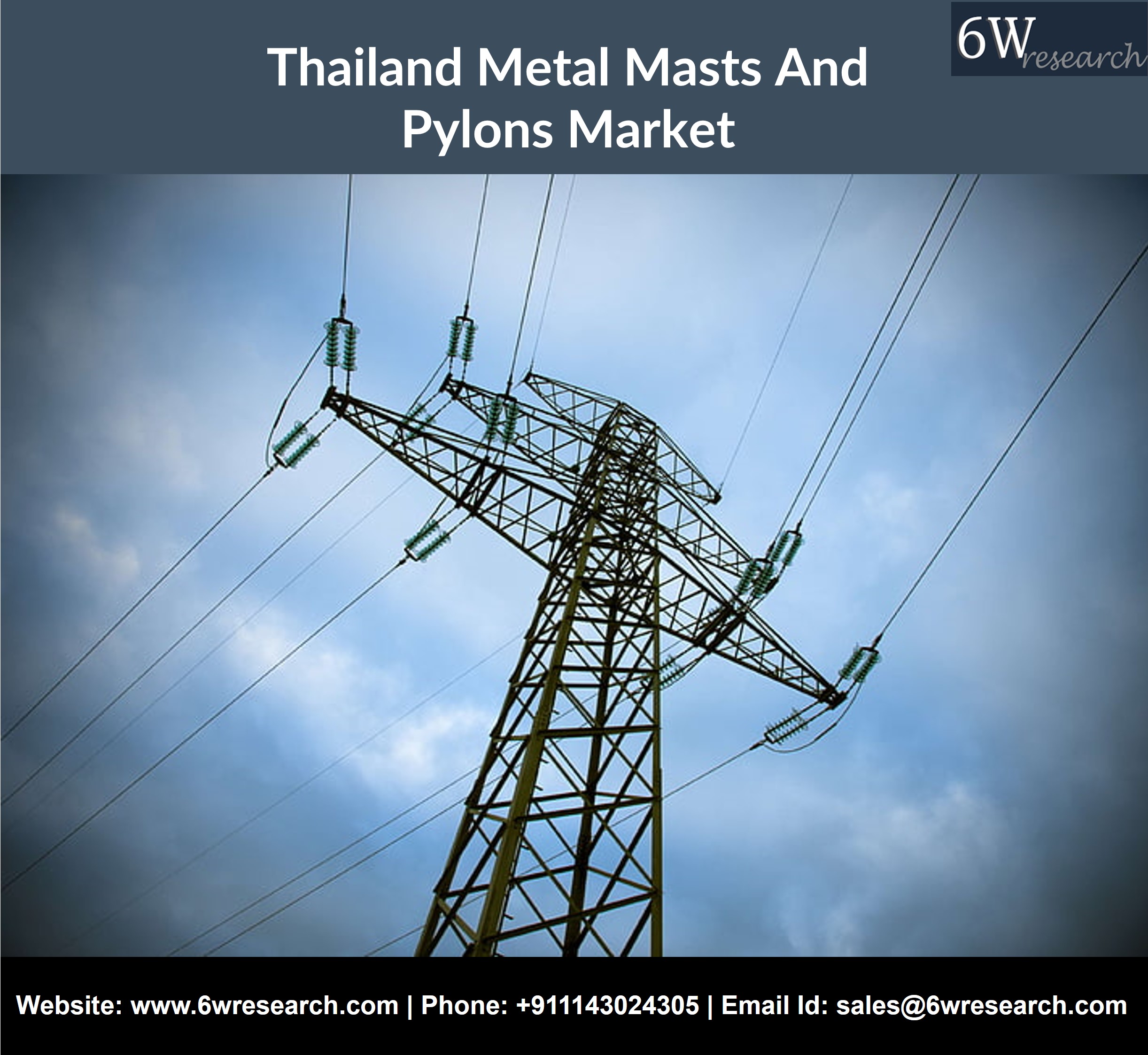
Thailand is a growing economy with a strong demand for infrastructure development, including the construction of communication and power transmission networks. Metal masts and pylons are essential components of these networks and are used for a variety of applications, such as lighting, traffic signals, telecom equipment, and power transmission lines.
The Thailand metal masts and pylons market in is highly competitive, with both local and international manufacturers vying for a share of the market. Local manufacturers dominate the market, but international players are also present, especially in the high-end and specialized segments.
The market is driven by government infrastructure spending, as well as private sector investments in commercial and residential construction. The Thai government has launched several large-scale infrastructure projects, such as the Eastern Economic Corridor, which involves the construction of high-speed railways, ports, and airports.
In addition, the Thai government has launched several initiatives to promote the use of renewable energy sources, such as solar and wind power. This has led to an increased demand for metal masts and pylons to support solar panels and wind turbines.
Overall, the metal masts and pylons market in Thailand is expected to continue growing in the coming years, driven by infrastructure development and increasing demand for renewable energy. However, the market is also subject to fluctuations in the global economy and the construction industry.
Trends in the Thailand Metal Masts and Pylons Market
Some of the key trends in the Thailand metal masts and pylons market include:
- Increasing demand for smart and sustainable infrastructure: There is a growing trend towards the construction of smart and sustainable infrastructure in Thailand, driven by government initiatives and private sector investments. Metal masts and pylons are essential components of these infrastructure projects, and as a result, there is a growing demand for products that are designed to be energy-efficient, environmentally friendly, and equipped with smart technology.
- Advancements in materials and manufacturing processes: Manufacturers are continuously exploring new materials and manufacturing processes to improve the quality and durability of metal masts and pylons. For instance, some companies are experimenting with composite materials that offer higher strength-to-weight ratios and are resistant to corrosion and weathering. Additionally, new fabrication techniques such as 3D printing are being adopted to create more complex and customized structures.
- Increasing focus on safety and aesthetics: Safety and aesthetics are becoming increasingly important considerations in the metal masts and pylons market in Thailand. In response to this, manufacturers are developing products that offer better visibility and meet stringent safety regulations, while also providing aesthetic value. This is particularly true in the high-end and specialized segments, where customers are willing to pay a premium for products that are both functional and visually appealing.
- Emphasis on customization and modularization: The market is moving towards more modular and customizable products, which can be easily assembled and disassembled. This is particularly relevant in the telecom and power transmission segments, where the rapid deployment of equipment is critical. Customers are demanding products that can be quickly installed and maintained, and manufacturers are responding by developing products that are easy to assemble and can be customized to suit specific requirements.
Overall, the metal masts and pylons market in Thailand is dynamic and evolving, driven by advances in technology, changing customer needs, and government policies. Manufacturers who are able to stay ahead of these trends are likely to be successful in this highly competitive market.
Growth of the Thailand Metal Masts And Pylons Market
The Thailand metal masts and pylons market has been experiencing steady growth, driven by several factors:
- Government investment in infrastructure: The Thai government has been investing heavily in infrastructure projects, including roads, airports, and high-speed rail, which require metal masts and pylons for lighting and signage. The Eastern Economic Corridor (EEC) project is one of the most significant infrastructure projects in Thailand, with an estimated investment of USD 45 billion. This project involves the construction of industrial estates, ports, and airports in the Eastern region of Thailand, which is expected to create a significant demand for metal masts and pylons.
- Increasing demand for renewable energy: There has been a growing demand for renewable energy sources in Thailand, driven by government initiatives to promote the use of solar and wind power. Metal masts and pylons are an essential component of renewable energy infrastructure, as they are used to support solar panels and wind turbines. This has led to an increased demand for metal masts and pylons in the renewable energy sector.
- Growth of the telecommunications industry: The telecommunications industry in Thailand has been experiencing rapid growth, driven by the increasing penetration of smartphones and other mobile devices. Metal masts and pylons are essential components of telecom infrastructure, as they are used to support mobile base stations and other communication equipment. As a result, there has been a growing demand for metal masts and pylons in the telecom industry.
- Increasing urbanization and construction activities: Thailand has been experiencing rapid urbanization, with increasing numbers of people moving to cities. This has led to a surge in construction activities, including the construction of residential and commercial buildings, which require metal masts and pylons for lighting and signage.
Overall, the Thailand metal masts and pylons market is expected to continue growing in the coming years, driven by government investment in infrastructure, increasing demand for renewable energy, growth of the telecommunications industry, and rapid urbanization. However, the market is also subject to fluctuations in the global economy and the construction industry.
Drivers and Challenges of the Thailand Metal Masts and Pylons Market
There are several drivers and challenges in the Thailand metal masts and pylons market.
Drivers:
- Government investment in infrastructure: The Thai government’s investment in infrastructure projects, including the Eastern Economic Corridor, is driving the demand for metal masts and pylons. These projects require the installation of metal masts and pylons for lighting, signage, and power transmission.
- Increasing demand for renewable energy: The growing demand for renewable energy in Thailand is driving the need for metal masts and pylons to support solar panels and wind turbines. The Thai government has set a target of generating 30% of its energy from renewable sources by 2036, which is expected to further increase the demand for metal masts and pylons.
- Growth of the telecommunications industry: The rapid growth of the telecommunications industry in Thailand is driving the demand for metal masts and pylons for mobile base stations and other communication equipment.
- Increasing urbanization and construction activities: Rapid urbanization in Thailand is driving construction activities, which require metal masts and pylons for lighting and signage.
Challenges:
- Intense competition: The Thailand metal masts and pylons market is highly competitive, with local and international players vying for a share of the market. This competition has led to pricing pressures, and manufacturers are seeking to differentiate their products by offering better quality, durability, and customization.
- Fluctuations in raw material prices: The price of raw materials used in the production of metal masts and pylons, such as steel and aluminum, is subject to fluctuations in the global market. These price fluctuations can impact the profitability of manufacturers and may lead to price increases for customers.
- Technological advancements: Manufacturers must continually invest in research and development to stay competitive in the market. This investment is required to develop new materials and manufacturing techniques, as well as to incorporate smart technology into metal masts and pylons.
- Regulatory compliance: The Thailand metal masts and pylons market is subject to stringent safety regulations and standards, which can increase the cost of production and impact the time to market for new products.
Overall, the Thailand metal masts and pylons market presents both drivers and challenges, and manufacturers who can navigate these successfully are likely to be successful in the market.
Conclusion of the Thailand Metal Masts and Pylons Market
The Thailand metal masts and pylons market is experiencing steady growth, driven by factors such as government investment in infrastructure, increasing demand for renewable energy, growth of the telecommunications industry, and rapid urbanization. However, the market is also subject to challenges such as intense competition, fluctuations in raw material prices, technological advancements, and regulatory compliance.
To succeed in the Thailand metal masts and pylons market, manufacturers will need to differentiate their products by offering better quality, durability, and customization. They will also need to invest in research and development to develop new materials and manufacturing techniques, as well as to incorporate smart technology into metal masts and pylons.
Overall, the future of the Thailand metal masts and pylons market looks promising, with the ongoing government investment in infrastructure and increasing demand for renewable energy and telecom infrastructure expected to drive the demand for metal masts and pylons in the coming years.









